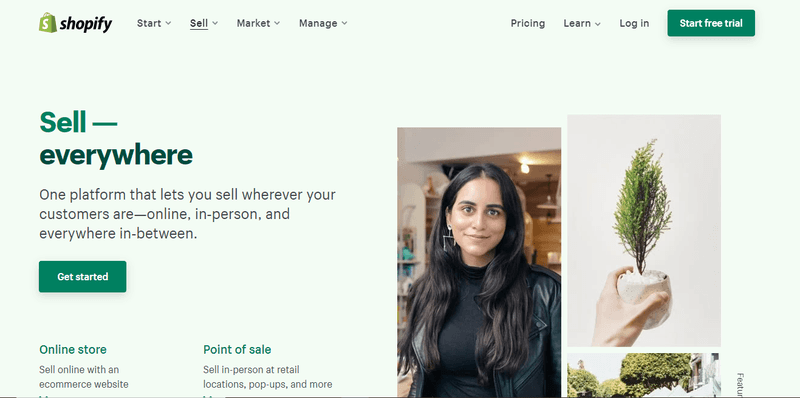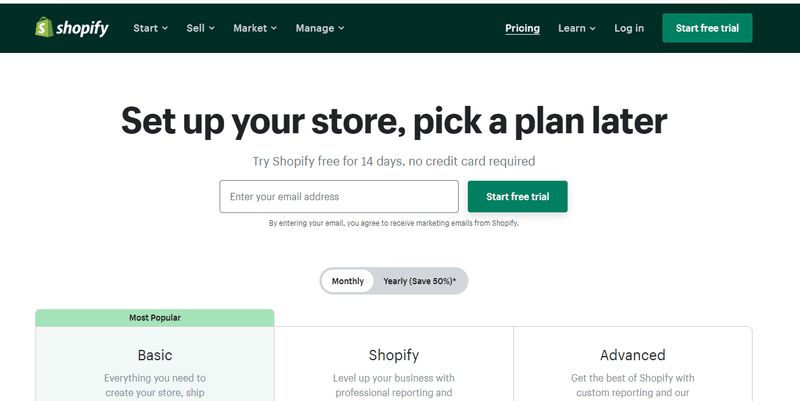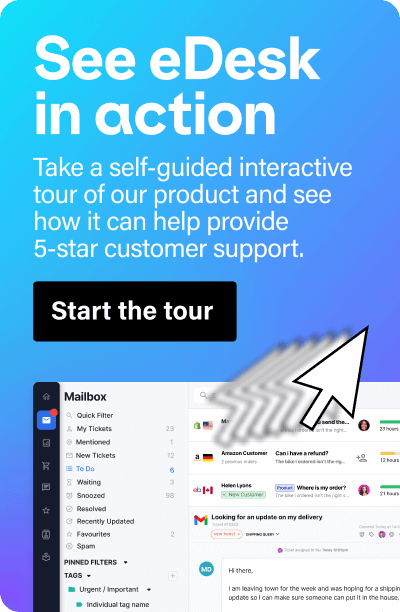Are you an eCommerce store owner looking to get more sales on Shopify?
There are plenty of online forums and blogs that offer tips, tricks and advice, from centralizing your customer support to earning positive reviews. Using well-known and well-established commerce platforms like Shopify is a great start, but where do you go from there? Perhaps you’ve been using Shopify for your business, but find that you simply aren’t getting the sales you’d like to see.
In the world of eCommerce, you can often see how much traffic your site is getting. Low traffic obviously means lower sales, but what if you’re seeing reasonable or even high traffic numbers on your site but not enough sales? Let’s discuss some possible reasons for low Shopify sales, as well as a few tips and tricks you can use to boost your sales.
If you’d like to learn how to boost your sales on Shopify, read on.
TL;DR

- Shopify is an online commerce platform that allows you to create a virtual store and branch out into other areas. It provides a secure and easily customizable base for your business and offers marketing tools, SEO insights, and data analytics. This can help you identify problems with your business early on and drive traffic back to your Shopify store.
- If you’re seeing reasonable or high traffic numbers to your site but poor sales figures, this could be due to poor navigation, bad product descriptions/images, poor site sign, checkout issues, lack of mobile optimization, bad reviews, or even the wrong target audience altogether. If your sales on Shopify start to dwindle, it could be due to dropping traffic or unaddressed queries and complaints.
- Ways to improve your sales on Shopify include making site improvements, honing in on your eCommerce, SMS, and email marketing, updating product pages, and using influencer marketing.
- Loyalty programs, discounts, promotions, shopping offers, and giveaways are all great ways to attract new customers as well as keep existing loyal customers.
- Improving your Shopify stats can reassure prospective customers, improve reviews and trustability, increase sales and conversion rates, and helps establish brand identity and visibility.
What is Shopify?

Shopify is an online commerce platform, designed to allow business owners to create their own online stores. The platform allows anyone to sell items from any connected compatible device and provides exclusive eCommerce web hosting, reducing a seller’s own maintenance and behind-the-scenes website work. Sellers can choose between tens of paid or free Shopify themes to give their store a specific look and feel.
On Shopify, users can earn trust badges and customize their sites, all of which go a long way to attracting and reassuring customers. Shopify also provides stats and data to review, allowing business owners to see how their store is growing, and identify any problem areas. There are integrations, automation, SEO, and marketing tools available, providing everything a growing business needs to thrive and branch out, reaching more customers than ever before.
In short, Shopify provides the perfect base for growth. A lot of the groundwork has already been put in, allowing business owners to focus on their products, sales, and customers.
Is Shopify expensive?

Shopify offers a 14-day free trial, but after that, you’ll have to pay. Ranging from a basic price of $29 per month to $299 per month, there are several pricing plans available. Paying for a platform like Shopify should be seen as an investment – money you’ll get back in benefits for your business.
Want to Learn About Shopify Alternatives?
Shopify is one of the most popular eCommerce platforms available today, but it’s not necessarily the best platform for you. If you like to know your options before you invest, you can check out some of our comparison reviews below.
- Shopify Plus Vs BigCommerce Enterprise
- Shopify Vs BigCommerce
- Shopify Vs WooCommerce
- Shopify Plus Vs Magento
In these reviews, we’ve compared the most important features of the top eCommerce platforms, so you can decide on which one is most suited to your budget and your needs.
For now, back to Shopify. What benefits of this particular platform can you expect to see?
Benefits of using Shopify

Shopify is designed to make your life easier, and allow you to focus on what’s really important – running your business. Here are a few benefits you might enjoy if you choose to use Shopify.
- Easy to set up and use
- Provides a secure and reliable platform for sales and customer info
- 24/7 customer support
- Easy to customize your site and make changes
- Already mobile-optimized
- An impressive app store (if you aren’t on social media, are you really in eCommerce?)
- Plenty of SEO features (search engine optimization, which is an absolute must for an eCommerce business) plus marketing tools

These are just some benefits you might enjoy if you invest in a platform like Shopify. But what if you already have a Shopify store and your sales are still low? What next?
Why are my Shopify sales low?

Your Shopify store will track the traffic coming to your site, as well as your sales on Shopify, and other crucial data. Regularly reviewing your analytics and customer data is essential to a successful eCommerce business, as it allows you to spot issues before they become issues.
So, let’s suppose you’ve spotted an issue. You’re enjoying high or reasonable traffic to your Shopify store, but your sales are much lower than expected. This means that you have a low conversion rate – a low rate of visitors that turn into paying customers.
So, in order to increase your eCommerce conversion rates, you need to ask yourself: what could be the problem?
Poor navigation and organization
Setting up a website is harder than it looks, especially if you have a large and complex product inventory. But if a customer visits your site and struggles to find the products they want, they’re going to give up and go elsewhere. After all, a website that’s more easily navigated is just a few clicks away!
Bad reviews/no trust
Bad or even neutral reviews can kill businesses. If your business has a bad reputation or bad reviews, the sales will dwindle away very quickly, and so will your traffic. You may want to check out your business on well-known business review sites like Trustpilot, to see what real customers have said about your business. Be aware that some customers may have left a bad review on online sites even if they didn’t reach out to you about a particular issue.
You may be hesitant to reach out for feedback, but customer input and reviews are crucial on all eCommerce platforms, not just Shopify.
We’ll discuss more on how to handle angry customers and earn back customer loyalty later.
Not optimized for mobiles
Surprisingly, many websites still aren’t automatically optimized for mobile users. As you probably know, the vast majority of internet users and online shoppers use mobiles and expect to be able to browse and buy via their mobile devices. If your website isn’t optimized for mobile users, they won’t be able to navigate your site properly and will go somewhere easier.
Poor product description
Product descriptions are key to site navigation, and good product descriptions build trust. If your products aren’t properly described, customers might not trust your site or may decide that your product isn’t right for them. They might also be unable to even find the product they need in the first place.
Bad images
It stands to reason that irrelevant, grainy, or inaccurate product images are not a good idea. However, product images can be almost overlooked in your site setup. Remember, customers will be scanning your page, waiting for something to stand out. Bad images are a major turn-off.
Poor store/website design
If your online store looks tacky, poorly put together, and difficult to navigate, customers are going to go somewhere else. You only have a few seconds to attract a customer’s attention. If you have a brand, your site needs to fit into that. Gaudy or clumsy sites can actually look like scam sites, which will put customers off and lowers trust in your business.
Wrong target audience
Knowing who your product is aimed at is the cornerstone of eCommerce – or any commerce, really. A good marketing campaign can help to reach the customers you’re aiming at, but if those customers have no need or interest in your product, you’re wasting your time and money. You may get visitors to your site, but they’ll quickly lose interest when they realize that your product isn’t for them.
Issues with your checkout page
A lot can go wrong between a customer clicking on your page and ultimately receiving their product. A simple technical error, like a customer being unable to complete their checkout, not being able to enter their payment details, or even not being able to add their products to their virtual shopping cart can tank your sales.
If you have high traffic and low sales, check out your buying process first, to make sure there isn’t a technical issue stopping would-be customers from buying your product. This sort of thing is incredibly frustrating and will put off even loyal customers.
14 Tips to improve Shopify sales

Perhaps you’ve identified one or even several of the issues mentioned above. Or there may be no glaring problem. If that’s the case, tweaking a few slightly problematic issues can do wonders for your Shopify store. Let’s take a look at 14 tips to improve sales on your Shopify store, while improving traffic and conversion rates.
Fix site flaws (including mobile optimization)

Start by fixing obvious site flaws. If a glitch in your site prevents shoppers from adding items to their virtual cart, this obviously needs to be dealt with before you do anything else. If your site isn’t optimized for mobiles, that needs to be fixed too – you’re cutting yourself off from a lot of prospective customers.
Make sure your site loads quickly. Internet users are used to instant results – we tend to lose patience with a site if it takes more than a second or two to load.
Automation is a great way to smooth out the buying process. If you want to give customers different platforms to buy (we’ll discuss branching out onto social media later), you’ll need to integrate your site with apps and other platforms.
Improve your site design
Once you’ve dealt with technical flaws, you need to take a look at your site design. This might not seem as important, but first impressions are everything.
As mentioned earlier, scam sites are rife, and they are often poorly designed, gaudy, or fake. You don’t want your customers to mistake the legitimate business you’ve worked hard on for a scam.
If you’ve designed your site yourself, you may need to take a good, hard look at your virtual decor. Look at the colors, the layout, and the ease of navigation. Is it an intuitive design? Is it tasteful? Does it look like a properly established, trustworthy site? If necessary, reach out to customers for feedback.
Understand SEO
Search engine optimization is key to getting traffic and sales on your site. SEO is vital for any eCommerce seller, regardless of their platform or product. A good grasp of SEO will help your business stand out among the noise and chaos of online sales. Properly updated product pages are another key way to improve your site – SEO keywords on product pages make it more likely that customers will stumble on your site and your product. Naturally, this means more sales.
Sometimes, low sales are simply the result of low traffic. You can’t expect to have a 100% conversion rate, but accurate SEO practices and keyword research can help you attract more relevant traffic to your site.
Understand your target audience (or choose a different target audience)
You need to target your service or product toward the people who need it. For example, suppose you sell cartoon backpacks. You need to make sure that children, parents, and young people are seeing your product. Aim towards social media sites that children tend to use, and create marketing pushes around times that children are likely to start needing backpacks – close to the start of the school term, for instance.
Marketing your product towards single adults, couples, or childfree adults is going to be an absolute waste of time. Even if you do everything right to hook these people towards your site, they’ll leave it straightaway because they have no interest in your product.
Start by creating a mock customer profile. This will help you understand who’s likely to be interested in your product, and then you can start to market your product to that person.
Branch out onto social media

Social media is an absolute must for most eCommerce sites. There is specially designed social media software available to help with your customer service. Utilize your online platforms to get in on popular holidays and sales seasons via social media.
Branching out to platforms like Instagram, Facebook, and TikTok can open up new sales channels and reach more customers than ever before. Most platforms (Shopify included) provide support and integrations which allow users to branch out onto social media.
Platforms like Instagram are particularly great for showcasing your brand, creating a strong online presence, and even building trust.
Make your mark with marketing

Once you’ve created your brand identity, revised your product pages, and invested in an eCommerce platform, it’s time to focus on marketing. As we discussed earlier, it is possible to find yourself reaching out to the wrong audience, in which case you’ll have to reassess your marketing strategies.
The good news is that eCommerce marketing can target all different types of customers, including previous and existing customers. Using Google Analytics can help you understand who is seeing your ads and how they are responding.
Google ads are a particularly great way of making your presence known. Like all advertisements, Google ads are an investment, but one that often pays off. Advertising on social media sites like Facebook can be another good way of reaching out.
On top of advertisements and publicity pushes, you’ll want to encourage customers to sign up for newsletters, SMS and email marketing, special offers, new updates, and more. For example, email feedback requests are a good way to increase engagement, increase sales, and get valuable reviews.
Email marketing can be tricky – customers don’t want an influx of irrelevant emails. Keep your email marketing pushes short and relevant, and make sure you’re providing interesting, high-quality content.
Influencer marketing is another handy tool. Less intrusive than email marketing campaigns, influencer marketing goes hand in hand with social media sales. Carefully choosing the right influencer for your niche and target audience can really help to increase sales both in your Shopify store and via your social media channels.
Create a personalized shopper experience
Customers want to feel special. eCommerce is a booming industry, with online sales at an all-time high and steadily growing. So, you have a lot of competition. Chances are, someone else is offering a similar product or service to you.
While it’s vital to keep your prices competitive, customers are looking for something that stands out from the crowd. If your site already ticks all the right boxes – trustworthy, easy to navigate, well-organized product pages, a strong brand presence, marketing via Google ads and other platforms, etc, you can give yourself a real advantage by providing a personalized experience. This can also help with customer retention, as a pleasant shopping experience will encourage customers to keep coming back.
eCommerce is not just a transaction. You need to create a smooth and enjoyable buying experience, right from the first time they browse your site to the moment they receive their product – and beyond. Make your Shopify store something a customer will remember.
You can help keep your business in your customer’s minds by regular email marketing. Be careful not to spam your customers, but be aware that more marketing generally equals more sales on Shopify.
Make sure your landing page has high conversions
Next, check out your conversion rate. A quick glance at your stats will show whether your sales on Shopify are less, more, or around the same as your store traffic. However, spending time calculating your conversation rate can be helpful, providing insight on how to increase sales.
For example, you may notice that a lot of visitors tend to buy, but the average order value is very low. This can impact your conversation rate and Shopify store stats. Figuring out how to improve your conversion rate and increase your average order value is the best way to explore your full potential as a business.
Retarget previous visitors
Customers who’ve already visited and bought from your site are more likely to come back. It’s far cheaper to keep an existing customer than it is to attract a new one. Obviously, a thriving business wants to do both.
You can use email marketing during holidays and sales seasons to convert casual site visitors into returning customers. Not only does this increase sales on Shopify and attract customers to your Shopify store, but it will also improve your trustability and create more good reviews online. Remember, getting more sales is not the only goal here!
More customers can mean more people signing up for email marketing and visiting your Shopify store.
Improve customer service and reach out for feedback
Don’t let your focus on getting more sales distract you from caring for your customers. Reaching out for feedback and reviews is absolutely crucial. You can combine automation and email marketing with feedback requests – try creating new and interesting email templates to get more feedback, encouraging customers to leave reviews on your Shopify store. This will naturally improve sales on Shopify, and improve your overall trustability as a business.
Social media provides an excellent platform for customer service. Customers may prefer to reach out via Instagram or Facebook for information, queries, or complaints. The more open channels you have for communication with your customers, the more appreciated they will feel.
However, be warned. On social media, the clock is ticking. Most customers expect a reply in less than a day, and on sites like Twitter, they might expect a response within an hour or two. The longer you leave it to reply to a complaint or query, the more annoyed the customer is going to get – this may lead to additional customer complaints.
Promotions, discounts, giveaways, and free shipping
If you want to get a customer’s attention, offer free shipping! This can help increase your sales on Shopify and on other channels. If you have a basic checkout price to qualify for free shipping, customers may be willing to buy extra products in order to qualify.
Loyalty programs are a great way to keep existing customers. Plus, discounts and giveaways are popular with all customers. Giveaways can be a good way of promoting your social media accounts and attracting a larger following.
Invest in live chat, chatbots, etc
Automation is certainly necessary for most businesses, but a personal touch and a real, live human to talk to is often the best way to go. Live chat can actually increase conversation rates and provides an opportunity to upsell, cross-sell, and deal with complaints before they become issues.
Live chat and chatbots are rapidly becoming the new norm in customer service. They’re useful for handling commonly asked queries and requests for information. Plus, a chatbot can put a customer’s mind at ease before they go through the buying process and reassures them that there will be plenty of support after they buy the product.
Highlight reviews and build trust
As we touched on earlier, shoppers now have to worry about accidentally getting scammed, or buying from a bad business that doesn’t provide high-quality products or any decent customer service. When you buy online, you buy on trust – trust that the product is as good as it’s advertised and that it’ll arrive at all. Customers trust a site with their credit card information, too. So it’s up to you as the business owner to show your customers they can trust you.
Shopify can help with this by providing trust badges, which have to be earned, and show customers that you’re a reliable, legitimate store that has earned its reputation. You can earn these badges by providing proper security for online checkout, offering various payment methods, and clearly outlining store policies.
You can also earn trust on social media sites. Users will be able to see how quickly you respond to messages and queries, and this will alter their opinion of your business. Facebook even offers specific badges to show how quickly you respond. This is handy if you use social media to handle customer service.
Focus on a more convenient customer experience
Last but certainly not least, take the time to improve your customer experience. We’ve discussed personalization, giveaways, discounts, loyalty programs, easy-to-use sites, and much more. To create a truly smooth and convenient customer experience, you’ll need to update all of these at once, if possible.
If your traffic is still high, fixing some glaring issues and starting work on the other problems should help to improve your sales stats. Keeping the customer as the cornerstone of your business is the best way to maintain your focus where it needs to be. It’s easy to forget about the customer in all the chaos over stats, marketing tools, and analytics.
Benefits of improving Shopify stats
The benefits of improving your Shopify stats are probably fairly obvious. However, let’s take the time to review four key ways that your business will be improved by better Shopify stats.
1. Customers are reassured
A well-established Shopify business reassures customers. If you earn trust badges and get good reviews online, customers know that you’re not a scam – you’re a legitimate business that deserves their time and possibly their money.
2. More sales and higher conversion rates
The Shopify tools provided for marketing and SEO can make your presence felt in the world of eCommerce. It can attract more traffic and subsequent sales to your site. This improves your overall conversion rate, which makes your eCommerce business more profitable and valuable. Marketing tools are investments, and necessary ones too.
3. Improves reviews and trustability
A good history of customer service, high-quality products, and regular updates to your site will always look good. Customers are obviously more likely to trust a well-reviewed and reputable site, especially if they’ve had a good experience there before.
4. Establishes a brand presence and identity
Customers prefer established brands, to the extent that people are willing to pay a little extra for a reputable brand over a less well-known business. Creating a brand identity allows you to reach the right customers for your business. This means that you can target your marketing campaigns more accurately, bringing in the right customers.
Brand identities can translate very well to social media. For example, Instagram is a great way to show your audience who your business is aimed towards and what you plan to achieve.
However, you need to make sure your brand identity stretches over all elements of your business – from your website design to the packaging your products arrive in. The influencers you use to promote your products should line up with your brand identity, and your social media accounts should be carefully curated to match.
FAQs
The world of eCommerce platforms and marketing tools can be a little confusing. Not every eCommerce platform is ideal, and choosing the wrong platform or the wrong marketing tool can seriously impact your sales. Let’s take a look at a few frequently asked questions regarding Shopify.
- What’s the success rate of a Shopify store?
Business ideas are easy and fairly common, but creating a profitable and long-standing business is extremely hard. While data varies depending on the type of store, approximately one out of every ten startups ultimately becomes successful. That’s one in ten. If you want to beat the odds, you have to be prepared and determined – and make your own luck.
- What is a good customer return rate on Shopify?
When it comes to repeat customer rates (that is, customers who choose to buy again from your business), a suitable rate is anything between 20-40%. A good figure to aim for is around 27%. You can learn more about your own business and your own return rate from Shopify stats and data.
- Are there alternatives to Shopify?
If Shopify isn’t suitable for your business for any reason, a popular alternative (especially for bigger businesses) is BigCommerce. BigCommerce provides a similar platform to Shopify and is highly rated by users. Both platforms have their pros and cons, so it’s worth doing your research.
- Why is Shopify a good platform for eCommerce?
Shopify provides speed and security, two essential components to a thriving eCommerce site. It provides options for customization, as well as vital stats, data, and marketing tools.
- Are there disadvantages to using Shopify?
One disadvantage to using Shopify is the price. While this is an investment that goes back into your business, it can be expensive for new businesses, especially ones that haven’t yet found a foothold in their niche. While the tools and security that Shopify offers can help a business grow, the initial expense can still be a problem.
Conclusion
ECommerce provides a world of opportunity, but if you want to increase your Shopify sales, there is a drawback – the competition. There’s a lot of profit to be made, and a lot of ways to turn an idea into a thriving business, but you’ll need to stay on top of the game if you want to succeed.
Follow the tips in this article to make a difference. Don’t wait for your sales and traffic stats to drop before you try new things or update your site. Keep up on popular trends, keywords, and opportunities. Do careful research before investing in marketing tools – while they’re very helpful, they can also be very expensive.
Most importantly, don’t let the chaos around new marketing tools and trends distract you from the most important part of the sales process: the customer.


